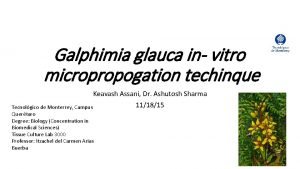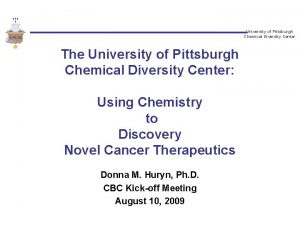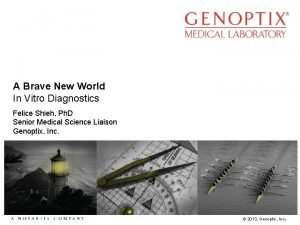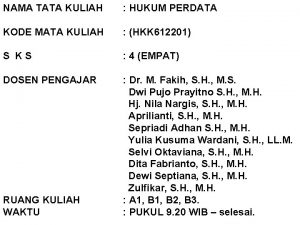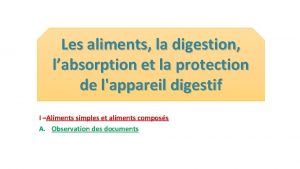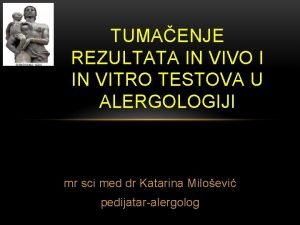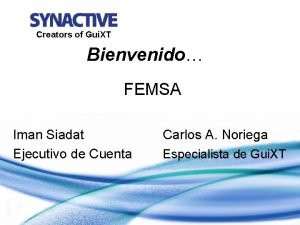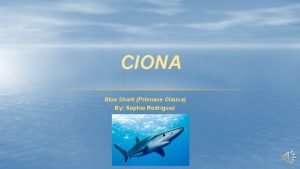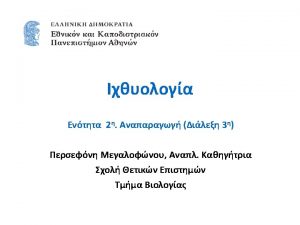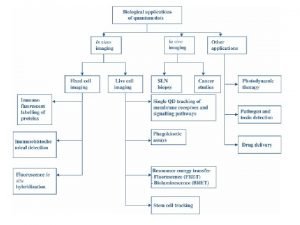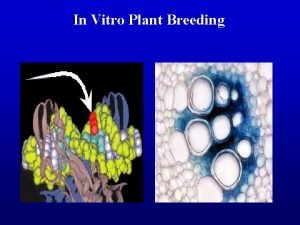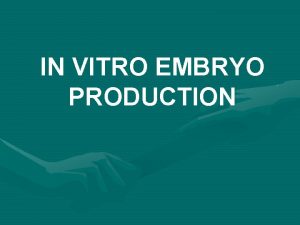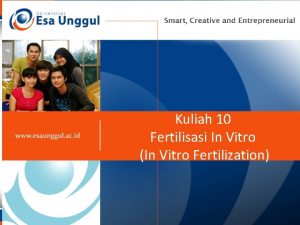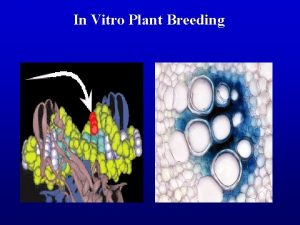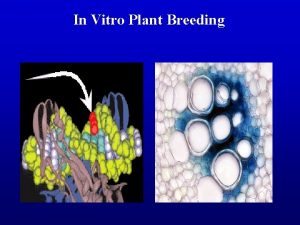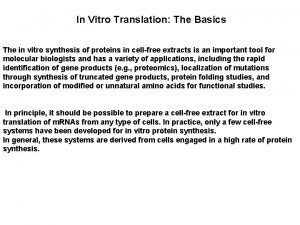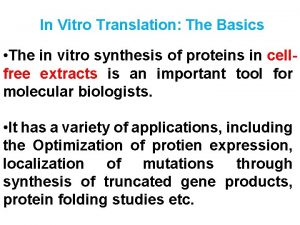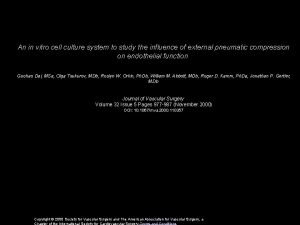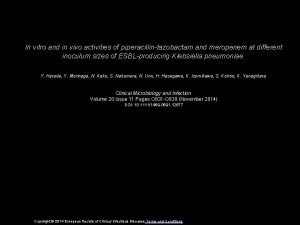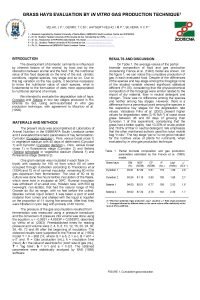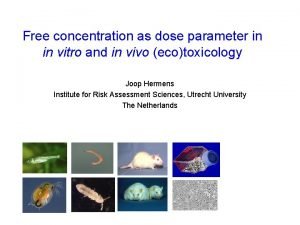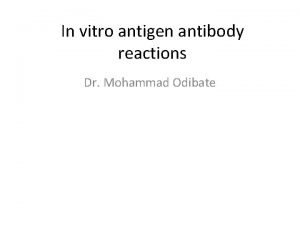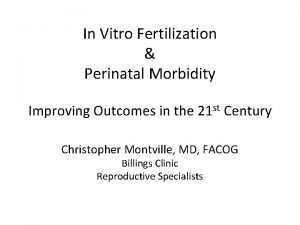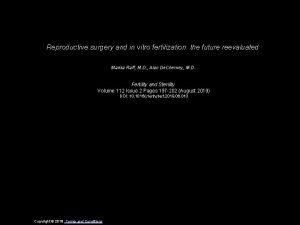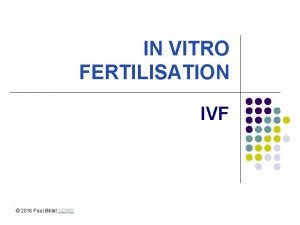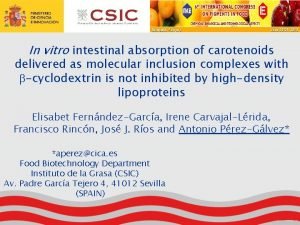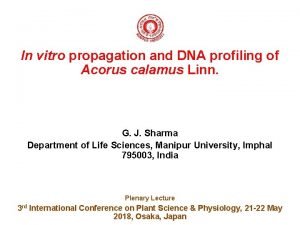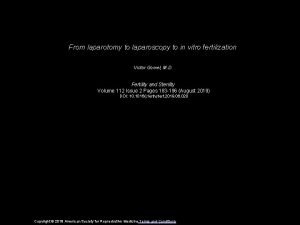Galphimia glauca in vitro micropropogation techinque Keavash Assani









































- Slides: 41

Galphimia glauca in- vitro micropropogation techinque Keavash Assani, Dr. Ashutosh Sharma 11/18/15 Tecnológico de Monterrey, Campus Querétaro Degree: Biology (Concentration in Biomedical Sciences) Tissue Culture Lab 3000 Professor: Itzachel del Carmen Arias Buerba

Introduction Galphimia glauca • Galphimia glauca is a small evergreen tropical shrub commonly found in Mexico and has been used over a long time for medicinal purposes. (Mangas 2006, Tortoriello 1992) • Extinction • Medicinal plant • Central nervous system • Anxiolytic disorders • Sleep deprivation

Characteristics • Galphimia appereance is characterized by flowers with yellow petals borne in racemes, either solitary or arranged in groups. Ten fertile stamens surround a tricarpellate ovary with three subulate styles. The globose fruit is a schizocarp that breaks into three 1 -seeded cocci. (Anderson 2007) • Known as “Good-Night” (Tortoriello 2015)

Clinical Trial Effectiveness CNS disorders Depression (Sharma 2012; Herrera 2006; Teut 2006; Abarca 2014; Armando 2014; González 2014; Guzmán 2014). Anxiety Kidneys, uterus, gastric ulcers, traumatic blows, wounds, scars, rheumatism inflation Folk illnesses such as nervous Related to stress and psychological distress

Conditions for growth Dependent on: genetic variation growing conditions timing and method of harvest exposure to air light moisture and type of preservation of the plant materials

Meristem tissue culture Meristematic tissue culture reduces contamination Rapid clonal multiplication A standardized method of extraction is essential to reproduce biological activity Free from virus Efficient in rooting techniques

Traditional Use • Mexico traditional medicine (Tortoriello and Lozoya 2007; Guzmán 2014) • 16 th century: Francisco Hernández • anti-dysentery, malaria, gastroenteritis and used to help women in labor • 20 th century: Maximino Martínez • emollient and used for wounds (Hernández 1959, Biblioteca Digital de la Medicina 2009) • Treatment for wounds, pimples, postpartum pain, inlfammation, tranquilizar, heart pain (Gómez and Chong 1985; Ortíz 1986).

Bioactive Constituents of G. Glauca Nor-seco-triterpenoids Fatty acids Flavenols Alkenes Metabolites • Many of the bioactive compounds such as the nor-seco-triterpenoids that display anxiolytic properties have been found in the aerial parts of the plant (González 2014).

• Many also display pharmacological effects: • • anti-inflammatory anti-malaric anti-allergic anti-asthmatic activities Diarrhea Gastroenteritis Dysentery (Tortoriello 2015 , Diaz 1976; Dorsch et al 1992; Neszmélyi et al. 1993; Camacho 1997 and Sharma et al. 2012).

Galphimines Galphimine. Most Active A (G-A) E (G-E) Most abundant anxiolytic compound in this plant Overall the most abundant galphimine Galphimine. B (G-B) Most potent anxiolytic galphimine Found at very low concentrations Inactive in its natural form, can be converted to G-A. Methodologically (González 2014). complicated to (Abarca 2014, Hierra 2006). isolate and purify (Drosh et al. 1992, A. Neszmélyi et. Al 2007).


Gallic acid, methyl gallate, and tetragalloylquinic acid • Anti-asthmatic effects • Tetragalloylquinic acid most active Flavenols: Kaempferol, Quercetin • Decrease anxiety • Inhibit the production of nitrates and prostaglandins-E 2 • Diminish cellular infiltration into rat granuloma air pouch • Reduce the activity of nuclear factor (NF)kappaβ and NF-kappaβdependent proinflammatory gene activity.

Background In-vitro development of G. glauca • IAA and Kinetin in MS medium on the Galphimia explants • From this experiment they were able to grow 20 shoots from a single bud within 60 days of culturing • A year later they extracted the secondary metabolites and obtained triterpenoid galphimine-B

• Other studies of G. glauca • Callus induction and cell suspension cultures • triterpene production • Two-stage culture process • maximize the biomass growth and G-B production. • Analyze effect of calcium alginate beads • G-B accumulation could be examined • Analyze the effects of G. glauca clinically and in vitro • Lack of studies on micropropogation of G. glauca

Hormones Effects Auxins initiate root Abscisic acid inhibitory effects in plant tissue culture Cytokinins Initiate shoot growth Gibberellins. inhibitory effects in plant tissue culture

Auxins Cyokinins indole-3 -acetic acid (IAA) indole-3 -butyric acid (IBA), 2, 4 -dichlorophenoxyacetic acid (2, 4 -D) 1 -naphthalenacetic acid (NAA) 2 i. P Kinetin BA BAP

Studies on Hormones-Auxins • IBA has shown to be more stable than IAA in plant tissue culture and thus is more efficient in promoting root growth (Tiberia 2015). • 2, 4 -D is a known callus inducer • NAA has been shown in successful formation of adventitious roots and is an obligatory phase of vegetative propagation in many woody plants and is stable at room temperature (Tiberia 2015). • combining two auxins it can be more efficient in root proliferation than only using one auxin (Osuna 2012).

Studies on Hormones-Cytokinins • 2 ip has been used in vitro to support in vitro propagation of micro shoot cultures from shoot tips and has been commonly used with zeatin. (Sigma Alrdich 2015). • Kinetin is an adenine/type cytokinins that is used to induce formation of callus and to regenerate plant tissues from callus (Sigma Aldrich 2015).

Root growth: • include cytokinins with auxins • Equal amounts form callus • Cytokinins at a lower level than auxins for root induction • Efficient levels of root proliferation with a 1/4 th and 1/3 rd concentration of cytokinins in relation to auxins (Tiberia 2015; Sadeghi 2014).

Justification • Traditionally used as a sedative as well as a medicine to treat neurological disorders. • Triterpene Galphimine-B has shown anxiolytic, sedative, spasmolytic, and other neurological properties • The production of Galphimia glauca through in vitro micropropogation is desired to obtain the triterpene/norsecofriedelanes. • Few micropropogation techniques

Hypothesis It is our hypothesis that the auxins NAA and IBA at different molar concentrations will produce varying root number and length growth. We hypothesize that together the two auxins will be better than with concentrations with only one of the auxins and also that extremes of the compounds will inhibit root formation.

Main Objective To obtain G. glauca in vitro with the best rooting possible, using meristem cultures.

Specific Objectives 1. 2. 3. 4. 5. Medium preparation Micropropagacion Medium with varying concentrations of IBA and NAA with half strength MS solutions and 1/3 th concentration of cytokinins 2 ip and Kinetin in relation to the auxins Root induction Data analysis

Method and Materials Obtain plant materials from Dr. Ashutosh Sharma that had previously been scarified with ethanol Merisetmatic tissue collected and used produce 250 shoots from four plants Shoot Production: MS media of macronutrients, and micronutrients full strength, vitamins, salts, sucrose and 1. 5 grams/L activated carbon Measure length of plant shoots once per week and subculture every two weeks (4 total)

Basal Media Prep: 50 % MS salts, macronutrients, micronutrients, and vitamins, without vegetable carbon. Multiple Concentrations of 0 u. M, 4 u. M, 10 u. M, and 40 u. M of both IBA and NAA mixes were mixed into the solutions with a 1/3 the concentration of cytokinins 2 ip and kinetin.

IBA 0 u. M 1 u. M 4 u. M 10 u. M 40 u. M NAA 0 u. M 0/0 0/1 0/4 0/10 0/40 1 u. M 1/0 1/1 ¼ 1/10 1/40 4 u. M 4/0 4/1 4/4 4/10 4/40 10 u. M 10/0 10/1 10/4 10/10 10/40 40 u. M 40/0 40/1 40/4 40/10 40/40

Eight plants were used for each concentration. The roots were measured using a compass every 2 days for 3 weeks and the number of roots were counted. Determine best rooting hormone combination

Results The only sign of roots was the swelling of the bottom of the shoots, which indicates that the roots are about to be induced.

Since no roots were observed, no number of roots were able to be counted. The length of the shoots in the flask has remained the same and the number of leaves per plant in each flask has also remained the same.

The shoots are healthy and but there is no observed root growth. The shoots can be shown to begin swelling at the bottom of the shoot.

Discussion • No root induction • Swelling of shoot bottoms • Study on inhibitory effects of IAA by Eliasson • High levels of IAA, IBA is very close in structure • Reversed by cobalt and silver ions (Eliasson 1989). • Effects of plant hormones on G. glauca unknown • Promote or inhibit growth

• Auxin development required for: • Root elongation • Gravity Response • Lateral root development (Ktekar and Geissler 1980; Muday and Haworth 1994) • Previous study with IBA and Kintetin • • IBA. 3 mg/L Kinetin. 1 mg/L Polyvinylpolypyrrolidone 1 mg/L 30 days (Rojas 2005)

Possible Problems • Time • Type of hormones used • Cytokinin interaction with auxins • Activated carbon in shoot phase but not root • Shown to induce radicate quality of roots (Chen 2012)

Conclusion • Main objective not reached • The results shown do not necessarily mean that the plants will not grow roots. • Infected roots due to auxins potentially • No significant data collected • Lack of root induction • Further Studies • Different horones • No cytokinins • Activated carbon effect

Cost of experiment




Thank you for your attention Questions?

References • A Neszmélyi, et al. "Tetragalloylquinic Acid, the Major Antiasthmatic Principle of Galphimia Glauca. " Planta Medica 59. 2 (2007): 164 -7. Print. • Abarca Vargas, Rodolfo, et al. "Pharmacokinetic Study in Mice of Galphimine-A, an Anxiolytic Compound from Galphimia Glauca. " Molecules (Basel, Switzerland) 19. 3 (2014): 3120 -34. Print. • Anderson, C. (2007) Revision of Galphimia (Malphighiacea). University of Michigan Herbarium. • Armando Herrera-Arellano, et al. "Therapeutic Effectiveness of Galphimia glauca Vs. Lorazepam in Generalized Anxiety Disorder. A Controlled 15 -Week Clinical Trial. " Planta Medica 78. 14 (2012): 1529 -35. • Armando Herrera-Arellano, et al. "Therapeutic Effectiveness of Galphimia Glauca Vs. Lorazepam in Generalized Anxiety Disorder. A Controlled 15 -Week Clinical Trial. " Planta Medica 78. 14 (2012): 1529 -35. Print. • Biblioteca Digital De La Medicina, 2009. Web. 30 Oct. 2015. • Cardoso, A. Et al (2004) Isolation of Nor-secofriedelanes from the Sedative Extracts of Galphimia glauca. Departamento de Farmacia, Facultad de Quı mica, Universidad Nacional Autónoma. • Diaz. Uso de las Plantas Medicinales de México. Instituto Mexicano para el Estudio de las Plantas Medicinales. Editorial Libros de México, Mexico (1976) p. 329 • Dorsch W, Bittinger M, Kaas A, Müller A, Kreher B, Wagner H. Antiasthmatic effects of Galphimia glauca, gallic acid and related compounds prevent allergen and platelet-activating factor-induced bronchial obstruction as well as bronchial hyperreactivity in guinea pigs. Int Arch Allergy Immunol. 1992; 97 1 -7 • Gómez, L. , Chong, E. , 1985. Conocimiento y Usos de la Flora de Amatlán, Municipio de Tepoztlán, Morelos. Tesis. Facultad de Ciencias, UNAM. México, p. 91. • González-Cortazar, Manasés, et al. "Anti-Inflammatory Activity and Chemical Profile of Galphimia Glauca. " Planta Medica 80. 1 (2014): 90. Print. • Guzman, L. (2014) Medicinal plants for the treatment of “nervios”, anxiety, and depression in Mexican Traditional Medicine. Revista Brasileira de Farmacognosia • Guzman, L. et al (2009) SEDATIVE ACTIVITY OF SOME PLANTS USED IN MEXICO TO TREAT INSOMNIA. Research Gate. • Hernández, F. 1959. HItoria de las plantas de Nueva España, In: Historia Natural de Nueva España Volumenes I y II, Obras Comletas Tomos II y III, Universidad Nacional Autónoma de México, México. P 476. And p. 554. • Herrera, A. (2007) Efficacy and tolerability of a standarized Herbal Prodcut from Galphimia Glauca on generalized anxiety disorder. A randomized, double blind clinical trial controlled with lorazepam. Planta Med • Herrera-Ruiz, M. , et al. "Anxiolytic and Antidepressant-Like Activity of a Standardized Extract from Galphimia Glauca. " Phytomedicine 13. 1 (2006): 23 -8. Print. • Lidia Osuna, et al. "Immobilization of Galphimia Glauca Plant Cell Suspensions for the Production of Enhanced Amounts of Galphimine-B. " Planta Medica 74. 1 (2008): 94 -9. Print. • Linares et al. , 1995 Linares, M. E. , Flores P. B. , Bye R. , 1995. Selección de Plantas Medicinales de México. Limusa-Noriega, México. • Mangas, Susana, et al. "The Effect of Methyl Jasmonate on Triterpene and Sterol Metabolisms of Centella Asiatica, Ruscus Aculeatus and Galphimia glauca Cultured Plants. "Phytochemistry 67. 18 (2006): 2041 -9. • Nader B, Cardoso A, Iturriaga G, Pereda-Miranda R, Villarreal M L. Genetic transformation of Galphimia glauca by. Agrobacterium rhizhogenes and the production of norfriedelanes. Planta Med. 2004; 70 1174 -9 • Ortíz, S. A. , 1986. Contribución al conocimiento de las plantas medicinales de Xoxocotla, Morelos. Tesis. Facultad de Ciencias Biológicas, UAEM, México. • Osuna L, Pereda-Miranda R, Tortoriello J, Villarreal M L. Production of the sedative triterpene galphimine B in. Galphimia glauca tissue culture. Planta Med. 1999; 65 149 -52

• Osuna L, Pereda-Miranda R, Villarreal M L. In vitro production of sedative galphimine B by cell suspension cultures of Galphimia glauca. Biotech Lett. 2002; 24 257 -61 • Sharma, Ashutosh, et al. "A Comparison on the Metabolic Profiling of the Mexican Anxiolytic and Sedative Plant Galphimia Glauca Four Years Later. " Journal of ethnopharmacology 141. 3 (2012): 964. Print. • Sharma, Ashutosh, et al. "DNA Barcoding of the Mexican Sedative and Anxiolytic Plant Galphimia Glauca. " Journal of ethnopharmacology 144. 2 (2012): 371 -8. Print. • Teut, Michael, et al. "A Homoeopathic Proving of Galphimia Glauca. " Forschende Komplementärmedizin (2006) 15. 4 (2008): 211. Print. • Tortoriello J, Romero O. Plants used by Mexican traditional medicine with presumable sedative properties: an ethnobotanical approach. Arch Med Res 1992; 23; 111 -6 • Tortoriello J. , and Lozoya X. "Effect of Galphimia Glauca Methanolic Extract on Neuropharmacological Tests. " Planta Medica 58. 3 (2007): 234 -6. Print. • Tortoriello J, Lozoya X. Effect of Galphimia glauca methanolic extract on neuropharmacological tests. Planta Med. 1992; 58 234 -6 • Tortoriello J, Ortega A, Herrera-Ruiz M, Trujillo J, Reyes-Vazquez C. Galphimine-B modifies electrical activity of ventral tegmental area neurons in rats. Planta Med. 1998; 64 309 -13 • Tortoriello J, Ortega A. Sedative effects of galphimine B, a nor-seco-triterpenoid from Galphimia glauca. Planta Med. 1993; 59 398 -400 • Tortoriello, et al. "New Anxiolytic Phytopharmaceutical Elaborated with the Standardized Extract of Galphimia Glauca. " Planta Medica 78. 11 (2012): PI 414. Print. • Tortoriello, J. et al (2011) New Anxiolytic Phytopharmaceutical Elaborated with the Standardized Extract of Galphimia glauca. • Tortoriello, J. et al (2015) Aplicación clínica de un ansiolítico obtenido de Galphimia glauca. 1 congreso Iberoamericano de fitoterapia. • Toscano R A, Ortega A, Maldonado E, Gaviño R, Lozoya X, Tortoriello J. Structure of galphimine B. Acta Crystallogr. 1993; C 49 774 -6

